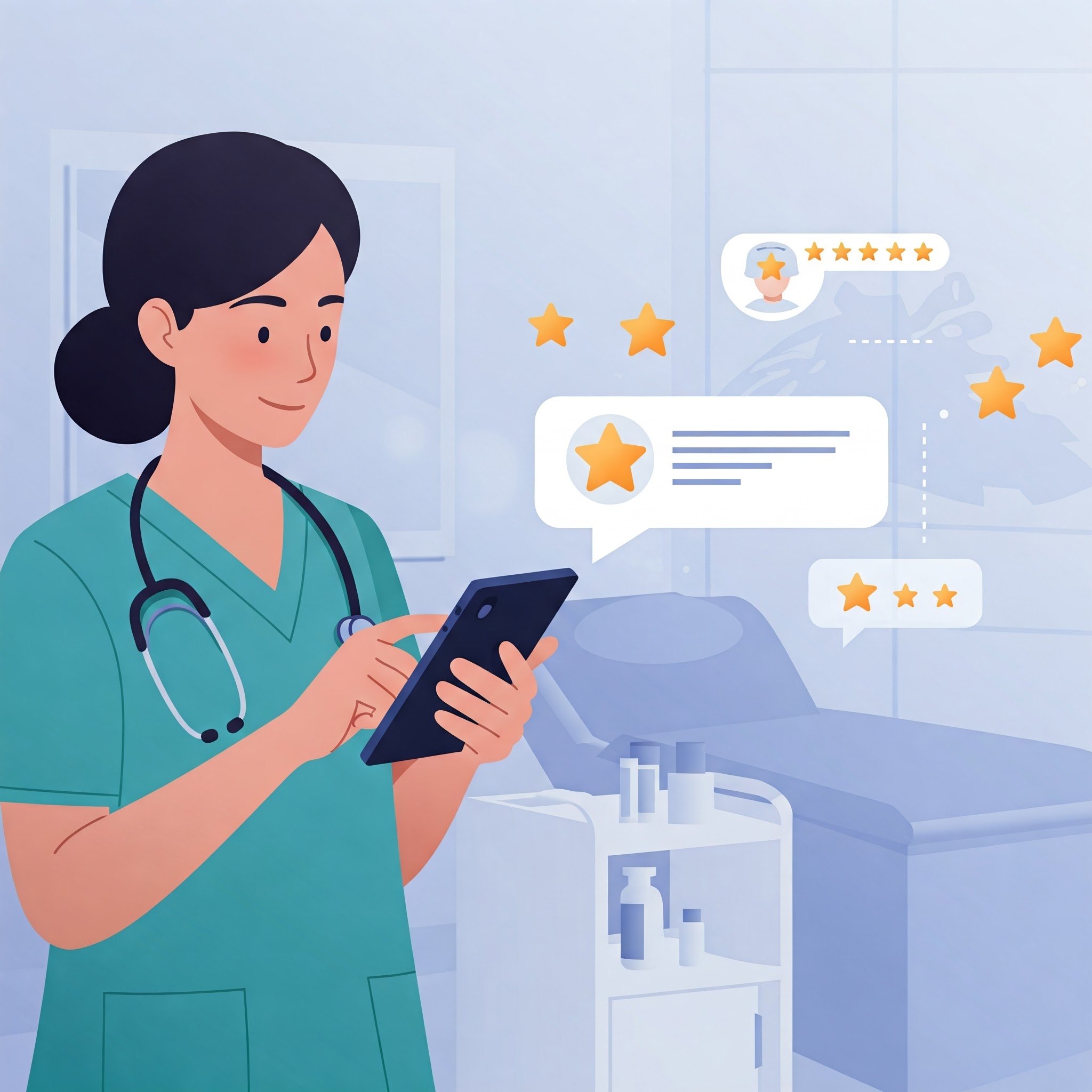12+ Actionable Strategies: How to Get More Patient Reviews and Attract New Patients
Learning how to get patients to leave reviews is a cornerstone of modern medical practice growth and involves simplifying the review process,...
28 min read
Alvin Amoroso : 5/7/25 9:00 AM

Imagine a world where every patient leaves your practice happy, and eager to share their positive experiences. But as a healthcare professional, do you know the best way to ask for reviews? With real-life examples and techniques, this article will equip you with the tools to ask patients for reviews effortlessly, helping you boost your practice's online presence and patient satisfaction.
The reputation of your healthcare practice online is a powerful factor in building patient trust and attracting new clientele. Testimonials from those you've treated often resonate more deeply than promotional materials. Statistics highlight this trend: 84% of people regard online reviews with the same trust as personal suggestions, and almost all consumers (98%) check reviews for local services. In the healthcare field, where trust is fundamental, genuine patient feedback is critical currency for demonstrating value.

Despite understanding its value, implementing a consistent process for gathering reviews can be tricky. Balancing sensitive patient communication with the need for feedback raises questions about the right approach, ideal timing, and strict HIPAA considerations. This complexity causes many practices to avoid asking directly, thereby missing chances to showcase positive outcomes. As a result, unprompted negative comments can sometimes unfairly dominate the online conversation, potentially steering prospective patients away.
This detailed guide is designed precisely to address these concerns and empower your team. We examine the most successful, ethical, and patient-friendly techniques for gathering testimonials. You'll find numerous specific asking patients for review examples, learn actionable methods, see sample language, receive tips on the best platforms and moments to ask, and get vital information on staying HIPAA compliant. Leveraging these asking patients for review examples is a foundational step toward building a stronger online reputation.
Before diving into the 'how', let's solidify the 'why'. Understanding the profound impact of patient reviews specifically within the healthcare landscape underscores the importance of making review generation a strategic priority. It's not merely about collecting star ratings; it's about building a foundation of trust, transparency, and continuous improvement.
Understanding these benefits clarifies that asking for reviews isn't a self-serving task; it's a vital activity that supports patient acquisition, enhances care quality, and builds a resilient, trusted healthcare practice.
Before implementing any review request strategy, it's absolutely essential to establish a framework grounded in ethical practices and strict adherence to the Health Insurance Portability and Accountability Act (HIPAA). Trust is the bedrock of the patient-provider relationship, and any misstep in handling patient information or soliciting feedback can irrevocably damage that trust and lead to significant legal consequences.

Building your review strategy on this ethical and compliant foundation is non-negotiable. It protects your patients, your practice, and ensures the feedback you gather is authentic and trustworthy. Every Asking Patients for Reviews Examples you implement should align with these principles.
Just as crucial as how you ask is when you ask. Requesting feedback at the right moment significantly increases the likelihood of a response and ensures the feedback is relevant and based on a fresh experience. Conversely, asking at the wrong time can feel intrusive or inappropriate, potentially damaging rapport.
Optimal Moments to Request Patient Reviews:

Critical Times to AVOID Asking for Reviews:
Bonus Timing Tips:
Mastering the timing requires situational awareness and empathy. Train your staff to recognize appropriate moments and, equally importantly, moments when a request should be deferred. Thoughtful timing makes your Asking Patients for Reviews Examples far more effective.
Not all review platforms are created equal, especially in healthcare. While general platforms are important, niche sites dedicated to healthcare providers often carry significant weight with patients seeking specific medical services. Focusing your efforts on the platforms most relevant to your patients and specialty is key to an efficient strategy.

Developing Your Platform Strategy:
By strategically selecting and managing your presence on the right platforms, you ensure your efforts in Asking Patients for Reviews Examples are directed where they will have the most impact.

Now we arrive at the heart of the matter: the specific methods and language you can use to request reviews effectively and ethically. There's no single "best" way; a multi-pronged approach, integrating requests naturally into various patient touchpoints, typically yields the best results. Remember to always ground these methods in the ethical and HIPAA-compliant principles discussed earlier.
Asking for a review face-to-face can be highly effective due to the personal connection, but it also requires the most finesse. It leverages rapport built during the visit but needs careful timing and non-pushy language. Many find that asking face-to-face can be highly effective when done right. The direct interaction allows you to gauge the patient's mood and tailor the request.
More In-Person Asking Patients for Reviews Examples:
In-person requests, when executed thoughtfully and consistently, can be a cornerstone of your review generation strategy.
Email remains a powerful communication channel for reaching patients after their visit. It allows for personalization, easy inclusion of direct review links, and can be automated for efficiency. A high percentage of consumers check email daily.
Benefits:
Key Strategies for Email Requests:
Subject: How Was Your Recent Visit to [Practice Name], [Patient Name]?
Dear [Patient Name],
Thank you for choosing [Practice Name] for your healthcare needs. We hope your visit on [Date] went smoothly.
We are always striving to provide the best possible care, and your feedback is essential in helping us achieve that goal.
If you have a moment, we would greatly appreciate it if you could share your experience by leaving us a review on Google. Your honest insights help other patients and allow us to continually improve.
[Click Here to Leave a Google Review]
Thank you for your time and consideration.
Sincerely, The Team at [Practice Name] [Practice Website Link]
Subject: Share Your Experience with [Practice Name]!
Dear [Patient Name],
We hope you’re feeling great after your recent visit with Dr./Provider [Provider Last Name] at [Practice Name]. Providing exceptional care is our top priority, and hearing from you helps us ensure we're meeting your expectations.
Would you be willing to take a couple of minutes to share your experience online? Your feedback helps potential patients make informed decisions about their care and guides our efforts to enhance our services.
You can leave a review on your preferred platform below:
[Leave a Review on Google] [Leave a Review on Healthgrades]
We truly appreciate you trusting us with your care and thank you for considering sharing your feedback!
Warmly, The [Practice Name] Team [Practice Phone Number] [Practice Website Link]
Subject: Checking In & Hoping You're Recovering Well, [Patient Name]
Dear [Patient Name],
We're just checking in following your procedure on [Date]. We hope your recovery is going smoothly and you're starting to feel better.
As you reflect on your experience with us, from consultation through to the procedure and follow-up, we would be very grateful for your feedback. Hearing about your journey helps us refine our process and support future patients.
If you feel comfortable doing so, please consider sharing your thoughts in an online review:
[Share Your Experience Here - Link to Preferred Platform]
Please don't hesitate to reach out if you have any questions during your recovery.
Best regards, Dr. [Provider Last Name] and the Team at [Practice Name] [Practice Website Link]
Remember to test different subject lines and body copy to see what resonates best with your patients. Email provides a flexible and effective channel for gathering valuable feedback when used thoughtfully. These Asking Patients for Reviews Examples offer a strong starting point.
Text messages boast incredibly high open rates, often within minutes of receipt. This makes SMS a powerful tool for quick, timely review requests, especially appealing to mobile-savvy patients. However, brevity and compliance are key.
Benefits:
Best Practices for SMS Requests:
Template 1: Simple & Friendly
Hi [Patient Name], thanks for visiting [Practice Name] today! We'd love your feedback. Tap here to leave a quick review: [Short Link] - Reply STOP to opt out.
Template 2: Slightly More Formal
[Practice Name]: Hello [Patient Name], we appreciate you choosing us. Could you spare a moment to share your experience from today's visit? Your feedback helps us improve: [Short Link] - Reply STOP to end msgs.
Template 3: Mentioning Platform
Hi [Patient Name] from [Practice Name]. Hope your visit went well! Please consider leaving us a review on Google: [Short Link] - It helps others find us! Reply STOP to opt out.
Template 4: Question Format
[Practice Name]: Hi [Patient Name], how did we do today? We value your opinion! Please leave a review here: [Short Link] - Thanks! Reply STOP to unsubscribe.
Template 5: Focus on Helpfulness
Thanks for coming into [Practice Name], [Patient Name]! Reviews help other patients make confident decisions. Would you mind sharing your experience? [Short Link] - Reply STOP to opt out.
Template 6: Post-Visit Check-in (Use 1-2 days later)
Hi [Patient Name], [Practice Name] checking in! Hope you're doing well after your visit. We'd appreciate your feedback when you have a moment: [Short Link] - Reply STOP to end.
Important Considerations for SMS:
SMS can be a highly effective part of your strategy for Asking Patients for Reviews Examples if used responsibly and compliantly, offering patients a very low-friction way to share their feedback.
Your practice website and patient portal are valuable digital assets that can be used to passively encourage and collect reviews without direct outreach for every patient.
Key Strategies:
Asking Patients for Reviews Examples for Website/Portal:
Integrating review opportunities into your website and portal provides a constant, low-pressure avenue for patients to share feedback at their convenience, complementing your direct outreach efforts. These passive methods contribute to your overall strategy for Asking Patients for Reviews Examples.
Social media platforms, particularly Facebook, can be used to foster community engagement and gently encourage reviews, but require extra caution regarding HIPAA compliance.
Key Strategies:
Asking Patients for Reviews Examples for Social Media:
Crucial Social Media Cautions:
Social media is best used for building community and brand presence, with review encouragement being a secondary, subtle goal, always prioritizing patient privacy. Use these Asking Patients for Reviews Examples carefully within this context.
Beyond the main digital channels, consider integrating review requests into other standard patient communications and materials.
Key Strategies:
These methods reinforce the message that you value feedback and provide additional, low-pressure opportunities for patients to respond when convenient. They contribute to making Asking Patients for Reviews Examples a consistent part of your practice culture.

Asking for reviews is only half the battle; responding to the feedback you receive is equally critical. Prompt, professional responses show that you are listening, value patient input, and are committed to patient satisfaction. Failing to respond, especially to negative reviews, can damage your reputation. Responding to reviews is a widely accepted best practice.
Why Respond?
Responding to Positive Reviews:
Asking Patients for Reviews Examples (Positive Responses):
Responding to Negative Reviews: This requires careful handling. The goal is to acknowledge, empathize, and move the conversation offline while adhering strictly to HIPAA.
Asking Patients for Reviews Examples (Negative Responses - HIPAA Compliant):
Example 1 (Standard): "Dear [Reviewer Name], Thank you for your feedback. We regret that your experience was not satisfactory. We take patient concerns very seriously and would appreciate the opportunity to discuss this further with you privately. Please contact our Practice Manager, [Manager Name], at [Phone Number] or [Email Address] at your convenience."Example 2 (Slightly More Empathetic): "Thank you for sharing your experience, [Reviewer Name]. We are sorry to hear we did not meet your expectations during your visit. Providing quality patient care is our top priority, and we would like to learn more about your concerns. Please reach out to our Patient Advocate at [Phone Number] so we can address this directly."Example 3 (Very Brief): "[Reviewer Name], we appreciate you bringing this to our attention. Please contact our office at [Phone Number] to discuss your experience further."Key Takeaway: Always respond, stay professional, prioritize HIPAA, and aim to resolve negative issues offline. Consistent and thoughtful responses complete the feedback loop initiated by your Asking Patients for Reviews Examples.
Once you've successfully gathered positive reviews and obtained necessary consent, you can leverage this powerful social proof to further enhance your practice's reputation and marketing efforts.
Ethical Considerations:
Leveraging positive feedback effectively amplifies the impact of your successful Asking Patients for Reviews Examples and strategies, turning satisfied patients into credible advocates.
While implementing your review strategy, be mindful of common pitfalls that can hinder your efforts, damage patient relationships, or even lead to compliance issues. Avoiding these mistakes is just as important as employing the right techniques.
By consciously avoiding these common errors, your practice can implement a review generation strategy that is effective, ethical, and patient-centric, making your efforts with Asking Patients for Reviews Examples truly successful.
Remember, a thoughtful, ethical, and patient-centered approach is key to successfully generating valuable online reviews. Utilizing effective Asking Patients for Reviews Examples is central to this process.
Mastering the art of Asking Patients for Reviews Examples is far more than a marketing tactic; it's about fostering a culture of open communication and continuous improvement within your healthcare practice. As we've explored, patient feedback is a powerful asset – building trust, attracting new patients, enhancing your online visibility, and providing invaluable insights into the patient experience.
The journey begins with understanding the critical importance of reviews in healthcare and establishing a foundation built on ethical practices and unwavering HIPAA compliance. From there, success lies in implementing a multi-faceted strategy: choosing the right moments to ask, leveraging the most effective channels (from personal in-person requests to automated email and SMS follow-ups), and making the process incredibly simple for your patients. Personalization, genuine appreciation, and clarity in your requests are paramount.
Remember to utilize the diverse range of Asking Patients for Reviews Examples provided throughout this guide as a starting point, adapting them to your specific practice culture and patient demographic. Don't forget the crucial step of responding thoughtfully and professionally to all reviews, closing the feedback loop and demonstrating your commitment to patient voices. Avoid common pitfalls like pressuring patients or offering unethical incentives.
By consistently and ethically integrating review requests into your patient interactions, you transform satisfied patients into powerful advocates. You build a robust online reputation that accurately reflects the quality care you provide, ultimately strengthening your practice and better serving your community. Start today – choose one strategy, refine your approach, and begin harnessing the immense power of patient feedback.

Learning how to get patients to leave reviews is a cornerstone of modern medical practice growth and involves simplifying the review process,...

Imagine if your patients could easily share their positive experiences with just a few taps on their phone. Getting patients to leave a review via...

In today's digital-first world, have you ever wondered how some businesses consistently capture attention and dominate Google searches while others...